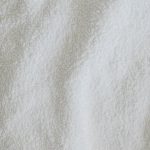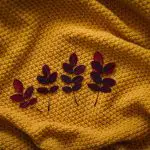When sewing different fabric types, mastering the best stitching techniques is essential for achieving professional results. Understanding fabric properties and selecting the right stitching technique can make a significant difference in the quality of your finished project.
Whether you're working with delicate fabrics like silk, stretchy knits, sturdy denim, heavy-duty canvas, or synthetic materials, each fabric type requires specific stitching techniques to ensure durability and a polished appearance.
By learning the best stitching techniques for different fabric types, you can confidently tackle a variety of sewing projects with precision and expertise.
Key Takeaways
- Different fabrics have different properties and require different stitching techniques.
- Delicate fabrics like silk and lace require special care and specific needle types.
- Lace fabrics should be stitched with a lightweight stabilizer and a short stitch length.
- Stretchy knits need to be stitched with a ballpoint needle and a stretch stitch or narrow zigzag stitch.
Understanding Fabric Properties
To stitch different fabric types effectively, you need to understand their properties. Fabric properties encompass a range of characteristics, including fiber content, weave, weight, stretch, and drape. Each fabric behaves differently when stitched, so understanding these properties is crucial for achieving quality results.
For instance, cotton is breathable and easy to sew, making it suitable for a wide range of projects. In contrast, satin is delicate and slippery, requiring special handling to prevent puckering and distortion.
Another aspect of understanding fabric properties is fabric care and maintenance. Knowing how a particular fabric should be cared for can impact your stitching decisions. For example, fabrics that require dry cleaning may not be suitable for projects that need frequent washing. Additionally, understanding how a fabric behaves when washed or ironed can help you anticipate any potential changes to the fabric's properties after stitching.
Stitching Techniques for Delicate Fabrics
When working with delicate fabrics like silk and lace, it's essential to use the right stitching techniques to avoid damaging the material.
Silk requires lightweight, sharp needles and fine, small stitches to prevent puckering and snags.
When sewing lace, techniques like hand-basting and using a zigzag stitch can help preserve the delicate nature of the fabric.
Silk Stitching Tips
You should always handle delicate silk fabrics with extra care when stitching to avoid any damage.
When it comes to silk embroidery, use a fine needle to prevent pulling and puckering of the fabric. A small embroidery hoop can help maintain the fabric's tension, making stitching easier and preventing distortion.
For silk seam finishing, consider using French seams, which encase the raw edges for a clean finish that reduces fraying. Alternatively, you can use a delicate zigzag stitch or pinking shears to prevent fraying on the edges.
When pressing silk seams, use a low heat setting on your iron and place a pressing cloth between the fabric and the iron to avoid shine or heat damage.
With these tips, you can confidently stitch delicate silk fabrics with precision and care.
Lace Sewing Techniques
When stitching delicate lace fabrics, handling them with care is essential to avoid damage and ensure precise stitching. To master lace sewing techniques, consider these tips:
- Use fine, sharp needles to prevent snags and maintain the delicate nature of lace edging.
- Employ a lightweight stabilizer to support sheer fabric while stitching, ensuring the fabric doesn't pucker.
- Opt for a short stitch length to maintain the integrity of the lace fabric.
- Experiment with a walking foot attachment on your sewing machine to prevent the layers from shifting during stitching.
- Test your stitching techniques on scrap lace fabric before working on your final project to ensure the best results.
Sewing Stretchy Knits
To sew stretchy knits, there are a few key considerations. First, select a ballpoint needle to prevent snagging the fabric. Ballpoint needles have rounded tips that slip between the knit fibers without causing damage.
When choosing a stitch for knit fabric, there are a couple of options to consider. You can opt for a stretch stitch or a narrow zigzag stitch. These options allow the fabric to stretch without the stitches breaking.
If you prefer using a standard straight stitch, there is a technique you can use to create a stretchy seam. Consider using elastic thread in the bobbin. This technique creates a stretchy seam that moves with the fabric.
When sewing with elastic thread, there are a couple of additional steps to keep in mind. First, wind the bobbin by hand to prevent overstretching. Additionally, adjust the tension settings on your sewing machine to accommodate the elastic thread.
For hems and edges, a twin needle can create a professional-looking finish while maintaining the fabric's stretch.
Remember to test your stitches on a scrap piece of fabric to ensure the settings are appropriate before sewing your actual project.
With the right tools and techniques, sewing stretchy knits can be a rewarding and enjoyable experience.
Mastering Sturdy Denim
Ready to tackle the challenge of mastering sturdy denim?
Let's start by selecting the right thick needle to handle the heavy fabric.
Next, we'll explore the technique of reinforcing with topstitching to add strength and durability to your denim stitches.
Thick Needle Selection
Select the appropriate needle size for stitching sturdy denim to ensure optimal results in your sewing projects. When working with thick denim fabric, it's crucial to use the right needle size and thread thickness to achieve professional-looking stitches and prevent any damage to your sewing machine.
Here's what you need to consider:
- Needle Size: Opt for a heavy-duty needle, such as a size 16 or 18, to easily penetrate through the sturdy denim without breaking.
- Thread Thickness: Use a thick, strong thread like topstitching thread to withstand the heavy-duty nature of denim and prevent snapped stitches.
- Needle Type: Consider using a sharp or denim needle specifically designed for dense fabrics to ensure clean and precise stitching.
- Machine Tension: Adjust the machine's tension settings to accommodate the thicker fabric and prevent puckering or skipped stitches.
- Stitch Length: Increase the stitch length to ensure smooth, even stitches on the thick denim material.
Reinforcing With Topstitching
Reinforce sturdy denim by mastering the art of topstitching. This technique ensures durability and a professional finish in your sewing projects.
When working with denim, topstitching serves a dual purpose. It reinforces the fabric and adds decorative detailing. To achieve this, use a heavy-duty thread that can withstand the rigors of denim.
In addition, using a longer stitch length prevents puckering and creates a clean, professional look. So, make sure to adjust your sewing machine settings accordingly.
When selecting a needle for topstitching denim, opt for a denim or topstitching needle. These needles are designed to pierce through the thick fabric with ease.
To achieve straight and even stitches, consider using a specialized topstitching foot. This foot helps guide your fabric and ensures precise stitching.
Furthermore, reinforcing stress points such as pockets and seams is crucial for enhancing the garment's strength. You can do this by using bar tacks or extra rows of topstitching in these areas.
Tension Adjustment Tips
To achieve optimal results when mastering sturdy denim, adjust your tension settings to accommodate the thickness of the fabric. Proper tension adjustment is crucial for preventing puckering or loose stitches on denim.
Here are some tips to help you master sturdy denim:
- Check Bobbin Tension: Ensure that the bobbin tension is set correctly to avoid loose or tight stitches.
- Use the Right Needle: Select a needle specifically designed for denim to penetrate the fabric without breaking or bending.
- Troubleshoot Tension Issues: If you encounter tension problems, troubleshoot by rethreading the machine and adjusting the tension dial.
- Experiment with Stitch Length: Test different stitch lengths to find the ideal setting for sturdy denim fabric.
- Practice on Scrap Fabric: Before working on your main project, practice adjusting the tension on scrap denim to achieve perfect stitches.
Mastering tension adjustment for sturdy denim requires attention to detail and practice with different settings and techniques.
Techniques for Heavy-Duty Canvas
When stitching heavy-duty canvas, your needle's size and strength play a crucial role in achieving durable seams. To ensure the best results, opt for a heavy-duty needle, such as a size 18 or 20, and use a high-quality polyester or nylon thread for added strength. Additionally, employing the correct stitching techniques is essential for heavy-duty seam construction. The following table outlines some key considerations for sewing heavy-duty canvas:
| Consideration | Description |
|---|---|
| Thread Selection | Choose high-quality polyester or nylon thread for strength and durability. |
| Needle Size | Use a heavy-duty needle, such as size 18 or 20, to sew through multiple layers of heavy canvas. |
| Stitch Type | Utilize a straight stitch or a reinforced stitch pattern for added strength and durability. |
Sewing Silk Fabrics
Selecting the appropriate needle and thread is essential for sewing silk fabrics to ensure smooth and delicate seams. When working with silk, it's crucial to handle the fabric with care to prevent any damage.
Here are some essential tips for sewing silk fabrics:
- Silk Care: Always pre-wash and press the silk fabric before starting your sewing project. Use a gentle detergent, and hand wash or use the delicate cycle on your washing machine. Avoid wringing out the silk, and instead, gently press out the excess water with a clean towel.
- Silk Thread Selection: Opt for fine silk threads that match the color of your fabric. Silk threads are smoother and less prone to causing snags or pulls in delicate silk fabric. This ensures that your seams aren't only strong but also blend seamlessly with the fabric.
Stitching Cotton and Linen
When sewing cotton and linen fabrics, you should carefully choose the appropriate needle and thread to ensure smooth and sturdy seams. Both cotton and linen are natural, breathable fabrics, and they require specific care to maintain their quality. When selecting the right thread for stitching cotton and linen, opt for a high-quality, all-purpose polyester thread or a cotton-wrapped polyester thread. These options provide strength and durability while maintaining flexibility.
For needle selection, choose a universal or sharp needle in a size appropriate for the fabric weight. A size 70/10 or 80/12 needle works well for lightweight to medium-weight cotton and linen fabrics, while a size 90/14 needle is suitable for heavier weights. Ensuring the appropriate needle and thread selection will result in professional-looking seams and prevent puckering or breakage during the stitching process.
| Fabric Care | Thread Selection |
|---|---|
| Gentle machine wash | High-quality all-purpose polyester |
| Iron on high heat | Cotton-wrapped polyester |
| Dry clean | |
| Avoid bleach |
Working With Synthetic Fabrics
To stitch synthetic fabrics effectively, you should use a specialized needle and thread designed for these materials. Synthetic fabrics, such as polyester and nylon, require specific tools and techniques for successful stitching.
When working with synthetic fabrics, consider the following:
- Seam sealing: Properly seal the seams of synthetic fabrics to prevent fraying and unraveling, ensuring the longevity of your stitched creations.
- Fabric bonding: Explore fabric bonding methods to join synthetic fabrics without traditional stitching, providing a seamless and durable finish.
- Needle and thread selection: Choose the appropriate needle and thread specifically designed for synthetic fabrics to ensure smooth and secure stitching.
- Heat tolerance: Consider the heat tolerance of synthetic fabrics when pressing seams, as excessive heat can damage or melt certain synthetic materials.
- Test stitching: Always conduct a test stitch on a scrap piece of the synthetic fabric to determine the optimal settings and techniques for your specific project.
Frequently Asked Questions
How Do I Choose the Right Needle for Different Fabric Types?
When choosing the right needle for different fabric types, consider the fabric weight and stretchiness. Use a fine needle for delicate fabrics and a thicker one for heavier materials. Adjust stitch length based on fabric stretchiness for optimal results.
What Are the Best Thread Options for Different Fabric Types?
When stitching different fabric types, consider the thread tension and stitch length. For delicate fabrics like silk, use a fine thread and lower tension. Heavier fabrics like denim require thicker thread and longer stitches.
Can I Use the Same Stitching Technique for Both Woven and Knit Fabrics?
You can't use the same stitching technique for both woven and knit fabrics. Stitching tension and fabric properties differ, affecting the sewing machine's performance. Woven fabrics need tighter stitching, while knit fabrics require more give to accommodate fabric stretch.
Are There Any Special Considerations for Stitching Fabrics With Embellishments or Beading?
When stitching fabrics with embellishments or beading, it's crucial to consider texture management and embellishment durability. Use specialized techniques for embellishment stitching and beading stitching to ensure the integrity of the fabric.
How Can I Prevent Puckering or Distortion When Sewing Different Fabric Types?
To prevent puckering or distortion when sewing different fabric types, adjust fabric tension and use appropriate stitch length. Proper tension and stitch length help the fabric feed evenly, reducing the risk of puckering or distortion.
- Does Chiffon Fabric Stink - July 15, 2025
- Does Chiffon Fabric Affect the Economy - July 15, 2025
- Does Cotton Fabric Have a Nap - July 15, 2025





